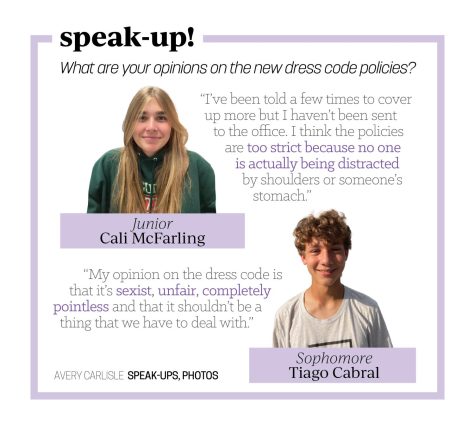Starting this school year, administrators have updated and become stricter about the dress code policies within this school. Some of these restrictions include students having to cover their midriff, torso, back and buttocks at all times. While this seems reasonable in most cases, problems with interpretation of the new policy have become evident. While it’s important to have a professional expectation for clothing at school, the current policy still has some flaws.
First, the policy is a bit too vague and still leaves gray areas in terms of interpretation. Administrators said they changed the policies to be more generalized with their clothing expectations; however, not having specific examples of what should be dress-coded leads to students getting flagged more often and for clothing for which they thought they shouldn’t be punished. By including examples of exact clothing items that violate school expectations in the CHS Handbook, staff will know exactly what to look out for and students will better understand how to follow the dress code.
Second, female students with more mature bodies endure an inordinate amount of discrimination when it comes to the changed dress code. The same shirt may look completely different on two different body types. Calling female students out for features outside of their control is one major way students claim the dress code sexualizes female students and makes them uncomfortable.

Admittedly, finding a dress code policy that is fair to everyone is difficult to accomplish. According to the National Education Association article, “When School Dress Codes Discriminate,” clothing that fully complies with dress code expectations is extremely difficult to find nowadays. In recent years, clothing styles have changed drastically and more stores try to keep up with youthful trends. In accordance with these trends, most of the current clothing choices available in stores for teenage females, for example, have some sort of cropped, ripped, short or fitted feature to them. Finding clothing that is both fashionable and meets restrictive school guidelines, therefore, is challenging, to put it mildly.
Found on page 19 in the CHS Handbook, one of the main reasons the administration is cracking down on clothing items is because of the school’s “dress for success” motto. In reality, though, one’s “success” is not defined by what a student wears. No matter how a student chooses to look, hard work and effort are the actions that lead to success, not covering skin. Furthermore, the common misconception that clothing is inherently distracting is a form of sexualizing students. Believing that male students cannot focus because of the clothes a female chooses to wear unfairly implies that girls’ natural, normal bodies are the issue and stereotypes men as immature predators in the classroom.
We agree that having a dress code is important in a professional environment, and we understand the administration’s desire to help prepare students for life outside of these walls. That being said, the current policy still needs some work. In order to ease this issue and help both students and staff, administrators should continue to update the dress code to be more clear with what the expectations are as well as to take into account current clothing trends.




























![Keep the New Gloves: Fighter Safety Is Non-Negotiable [opinion]](https://hilite.org/wp-content/uploads/2024/12/ufcglovescolumncover-1200x471.png)
















































![Review: “We Live in Time” leaves you wanting more [MUSE]](https://hilite.org/wp-content/uploads/2024/12/IMG_6358.jpg)
![Review: The premise of "Culinary Class Wars" is refreshingly unique and deserving of more attention [MUSE]](https://hilite.org/wp-content/uploads/2024/12/MUSE-class-wars-cover-2.png)
![Introducing: "The Muses Who Stole Christmas," a collection of reviews for you to follow through winter [MUSE]](https://hilite.org/wp-content/uploads/2024/12/winter-muse-4.gif)
![Review: "Meet Me Next Christmas" is a cheesy and predictable watch, but it was worth every minute [MUSE]](https://hilite.org/wp-content/uploads/2024/11/AAAAQVfRG2gwEuLhXTGm3856HuX2MTNs31Ok7fGgIVCoZbyeugVs1F4DZs-DgP0XadTDrnXHlbQo4DerjRXand9H1JKPM06cENmLl2RsINud2DMqIHzpXFS2n4zOkL3dr5m5i0nIVb3Cu3ataT_W2zGeDAJNd_E-1200x884.jpg)
![Review: "Gilmore Girls", the perfect fall show [MUSE]](https://hilite.org/wp-content/uploads/2024/11/gilmore-girls.png)
![Review in Print: Maripaz Villar brings a delightfully unique style to the world of WEBTOON [MUSE]](https://hilite.org/wp-content/uploads/2023/12/maripazcover-1200x960.jpg)
![Review: “The Sword of Kaigen” is a masterpiece [MUSE]](https://hilite.org/wp-content/uploads/2023/11/Screenshot-2023-11-26-201051.png)
![Review: Gateron Oil Kings, great linear switches, okay price [MUSE]](https://hilite.org/wp-content/uploads/2023/11/Screenshot-2023-11-26-200553.png)
![Review: “A Haunting in Venice” is a significant improvement from other Agatha Christie adaptations [MUSE]](https://hilite.org/wp-content/uploads/2023/11/e7ee2938a6d422669771bce6d8088521.jpg)
![Review: A Thanksgiving story from elementary school, still just as interesting [MUSE]](https://hilite.org/wp-content/uploads/2023/11/Screenshot-2023-11-26-195514-987x1200.png)
![Review: "When I Fly Towards You", cute, uplifting youth drama [MUSE]](https://hilite.org/wp-content/uploads/2023/09/When-I-Fly-Towards-You-Chinese-drama.png)
![Postcards from Muse: Hawaii Travel Diary [MUSE]](https://hilite.org/wp-content/uploads/2023/09/My-project-1-1200x1200.jpg)
![Review: "Ladybug & Cat Noir: The Movie," departure from original show [MUSE]](https://hilite.org/wp-content/uploads/2023/09/Ladybug__Cat_Noir_-_The_Movie_poster.jpg)
![Review in Print: "Hidden Love" is the cute, uplifting drama everyone needs [MUSE]](https://hilite.org/wp-content/uploads/2023/09/hiddenlovecover-e1693597208225-1030x1200.png)
![Review in Print: "Heartstopper" is the heartwarming queer romance we all need [MUSE]](https://hilite.org/wp-content/uploads/2023/08/museheartstoppercover-1200x654.png)



